|
I wrote this article in a month of sadness for all Thai people. On the night of 15 November 2008, a royal crematory ceremony was held for Her Royal Highness Princess Galyani Vadhana, the older sister of King Bhumibhol Adulyadej of Thailand. At Sanamluang, where the royal ceremony took place, there were some entertainments that were not only interesting but quite moving. These entertainments were performed in honor of the royal family and also as a sign to end the mourning period. They were performances of "The Birth of Ganesha" by the traditional Thai Puppet Theater (Joe Louis) which was under the royal patronage of the Princess, and this work held special and poignant meaning for the audience on this solemn occasion.
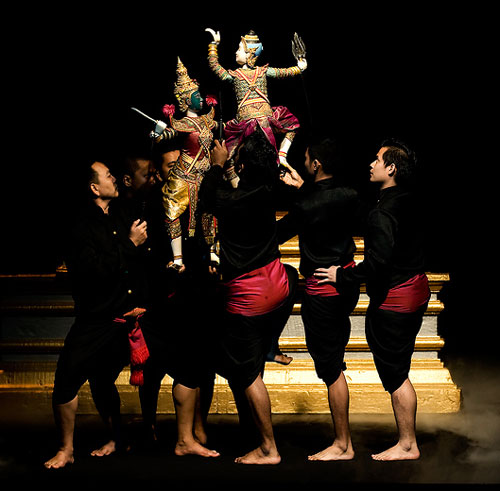
The Birth of Ganesha
Synposis
Isuan is in deep mourning for the loss of his consort, Satee. He becomes a recluse and an ascetic. The demon, Taraka, sees Isuan incapacitated by grief and wickedly plans to dislodge him as master of the universe. He asks Brahma to make him invincible and, seeing that Isuan has become an ascetic, concedes that the only person who would have the power to kill him would be Isuan's son. Brahma grants him is wish.
Upon obtaining his powers, he invades heaven with an army of demons. Taraka takes on Indra, but the gods are unsuccessful in their defence of heaven. Indra flees the battle and goes to Brahma to tell him what has happened. Brahma commands Karmasut, the god of love, to shoot his arrow at Isuan to make him fall in love with Uma, his late consort's reincarnation, so that he will have a child with her who will kill Taraka.
The scene changes. Isuan, who has denied himself the pleasures of this world, is seated on a rock. Uma approaches and offers him a garland. Karmasut, the god of love, fires his arrow (in fact, flowers). Isuan and Uma's eyes meet and they instantly fall in love.
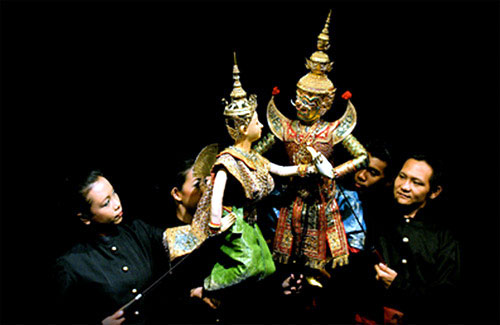
The scene changes. Isuan has gone on a retreat. Uma is fast asleep. Seated next to her is Vichaya, her lady-in-waiting. Loud noises are heard. Uma awakes and asks Vichaya what is the cause of the noises. Vichaya says the noises are caused by the invasion of heaven by demons led by Taraka. She advises Uma to have her door guarded. Uma withdraws into her boudoir and, from the perspiration of her body, she creates a child while being blessed with water from Kongka, the goddess of the waters. The resulting child – a large child – is Kumarn. Uma then tells Kumarn to guard the palace door.
The scene changes. Isuan, returning from his retreat, arrives at the palace door with Visukam. They are prevented from entering the palace by Kumarn. Isuan is angry. He orders Visukam to kill Kumarn. However, Visukam is defeated so Isuan throws his trident at Kumarn and severs his head. At that moment, Uma arrives and is horrified. She weeps abjectly. When Isuan asks, she tells him that the person whose head he has just severed is their son. Isuan is now horrified, too. He orders Visukam to go in a westerly direction to find the boy's head. Visukam leaves.
The scene changes. Visukam hands Isuan the severed head of an elephant, the only head he was able to find. By magic, Isuan moves the head and connects it with Kumarn's body. Kumarn comes back to life. Isuan names him Ganesha. Indra tells Isuan to send Ganesha to destroy the demons who are invading heaven. Indra and Ganesha leave.
The scene changes. Battle between the gods and the demons. First Indra then Ganesha arrive and join the fight. When the demons are vanquished, the senior demon Taraka appears. Taraka and Ganesha engage in a war of words during which Taraka tries to find out who Ganesha is. When Ganesha tells him he is the son of Isuan and Uma, he does not believe him: after all, Isuan had become an ascetic and would therefore not have a child! Taraka and Ganesha fight. Ganesha orders Buangbat – a giant serpent – to coil itself around Taraka and beats him to death with his club.
The final scene is of Ganesha seated on the great serpent and all gather around him to pay homage. Ganesha is venerated as the god of success and the patron of learning.
This was mesmerizing performance which was honred as one of the best puppet performances in February 2008 in Prague, Czech Republic.
Besides puppets from Joe Louis, there were some other notable performances:
Khon, a Thai revered production, is the blending of acting and dancing. Acting is like stage theater performance and dancing is like "Lakorn Nok" (all men performance). Originally, this performance was given to pay respect to the king and the royal family. Most performers are male, wear masks of giants, monkeys or other characters according to the roles in the story but they don't speak during the performance. The narrator tells the story and speaks in verse to the audience.
During the reign of King Narai Maharaj
of the Krungsri Ayudhaya Empire
According to the chronicle "Du Royaume de Siam" of Monsieur de La Loubere, a French diplomat from King Louise XIV of France, in the year 1693, he saw a performance for welcoming royal guests called "Khon". In addition, he also stated that Khon displayed dancing and acting with Thai musical instruments. The performers wore masks and held weapons.
Khon Ramakien was adapted from India's ancient epic literature "Ramayana" because it is believed by the Hindus that the king is the reincarnation of the god.
There was a full-set Khon performance after the royal funeral of Princess Galyani Vadhana. The performance was directed by "Kru Mued" Prasart Thongaram. It took about eight months of preparation and training. The Khon performers are mostly from the fine arts department and the dance institutes from every province of Thailand.
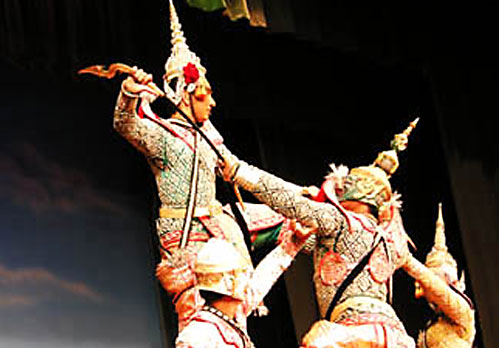
Kru Mued, the instructor and director of Nang Yai (shadow puppets) and the Khon performances for the royal funeral said that Nang Yai 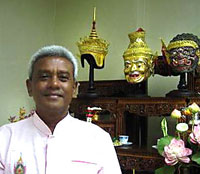 and Khon were performed on the main stage for 11 hours with nearly 2,000 performers. He pointed out that the traditional entertainments were well preserved and that they added some modern content to them without ruining the old arts. Not only all kinds of actors were presented such as "Phra(Male)", "Nang(Female)", giants, monkeys and others, but also ventriloquists, narration, singing and Thai musical instruments were essential. Almost everything must be in original and correct condition, if possible, in an ongoing attempt to preserve these Thai arts and traditions. and Khon were performed on the main stage for 11 hours with nearly 2,000 performers. He pointed out that the traditional entertainments were well preserved and that they added some modern content to them without ruining the old arts. Not only all kinds of actors were presented such as "Phra(Male)", "Nang(Female)", giants, monkeys and others, but also ventriloquists, narration, singing and Thai musical instruments were essential. Almost everything must be in original and correct condition, if possible, in an ongoing attempt to preserve these Thai arts and traditions.
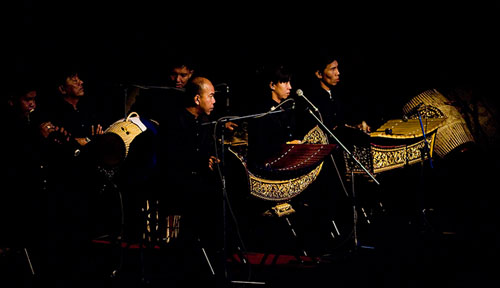
Khon performance combines many arts including dancing and costume. The dancing in combat scenes is derived from swords and club fighting (Krabi Krabong) but it was heavily modified to be the elegant and harmless fighting scene for the show. Puppetry, by the Office of the Performing Arts, Fine Arts Department, performing three episodes of Phra Aphai Mani.
The first puppetry troupe was founded in the year 1893, and after that puppetry became popular. The most popular puppetry shows were Phra Aphai Mani, Khun Chang Khun Pan, Krai Thong, Phra Vetsandorn and Laksanawong. Until 1979, only one puppetry troupe had a chance to do "Phra Aphai Mani." This was the beginning to resurrect Thai Puppetry. They developed the story from the original "Lakorn Nok" script and made bigger puppets to be easily seen by audiences.
Padetphat Plapprasong, the scriptwriter and director stated that his aim was to introduce puppetry as one of the entertainments in this tragic ceremony because puppetry was one of the premier performances for royal ceremonies such as celebrations, merit making and even funerals. "We could not rehearse on the real stage because all puppets were already dressed. It would not be exciting for the audiences when we did the actual performance if they watched a rehearsal," said Padetphat.
Traditional theatrical performances in six episodes, by the Bunditpatanasilpa Institute.
According to Dr. Supachai Chansuwan, the old understanding of "Lakorn Nok" and "Lakorn Nai" changed a bit. In the old times, Lakorn Nok was an all-male performance, and was shown for public audiences while Lakorn Nai was an all-female performance, only for the royal family. This tradition remains but nowadays the public can see both.
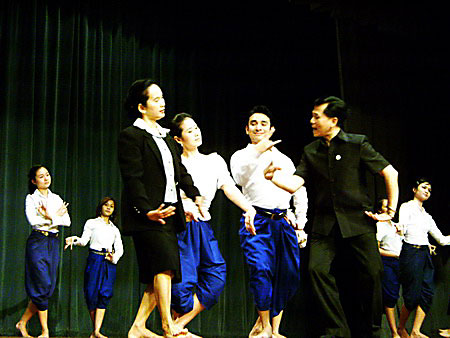
The chosen story for the show has strong meaning about luck, winning and happiness. This story is called "Suwannahong" and there are six episodes which took about three hours to finish. This was the last performance for the royal crematory ceremony at Tung Pra Meru Sanamluang Bangkok Thailand.
Photos - Mailak and manager.co.th
|


